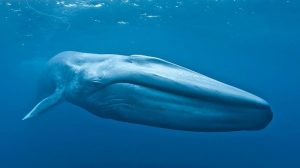Seychelles is a special place for whales and dolphins. And yet, while its corals, turtles and sharks are relatively well studied, little is known about its cetaceans. Now scientists from the University of Seychelles, Florida International University and Oregon State University are uncovering how remarkable Seychelles is for these mammals. In two field seasons they have recorded 23 species.

But one discovery looms large: the confirmation that blue whales frequent the same ocean where they were historically hunted.
“It is remarkable to know that the largest animal on earth swims here,” says Dr Jeremy Kiszka, a biology professor at Florida International University and a research associate at the Island Biodiversity and Conservation Centre, at the University of Seychelles.
Dr Kiszka is a Save Our Seas Foundation (SOSF) project leader investigating the importance of Seychelles for cetaceans. He co-authored “Acoustic detections and sightings of blue whales Balaenoptera musculus in the Seychelles, western tropical Indian Ocean (2020−2022)”, which was been published in the journal Endangered Species Research this month.
Seychelles was a hunting ground for Soviet whalers in the 20th century. As a new member of the International Whaling Commission in 1978, the Republic of Seychelles lobbied successfully to protect the Indian Ocean from whaling. And today, there have been five confirmed sightings over the course of five years.
“Never in my life would I have imagined that the biggest animal on planet earth cruises our oceans here in Seychelles,” says Ms Dillys Pouponeau, a research assistant at the SOSF D’Arros Research Centre (SOSF-DRC). Ms Pouponeau joined the expedition as a digital imaging technician with Oceanic Films who were filming “Blue Whales – Return of the Giants” with funding from the National Science Foundation and HHMI Tangled Bank Studios.
“To me this was big news because it reflects the productivity of our oceans,” she continues. “It shows how regulations have helped to protect this species after whaling.”
“Blue whales are protected because they are no longer legally hunted, but they still face a range of threats,” expands Dr Kiszka. “Shipping traffic causes noise pollution and can lead to collisions. Climate change is changing the distribution and abundance of their key food, krill.”
Of the four subspecies we know exist, it’s the pygmy blue whale that visits Seychelles. Scientists confirmed that the songs of the Sri Lankan acoustic group were recorded on their hydrophones.
“We now need to increase our research efforts to assess the abundance of these blue whales and discover why they are using Seychelles’ waters. We also need to raise awareness and help the government to protect them better,” says Dr Kiszka. “We need to raise funding to start dedicated research on blue whales.”
He and his colleagues will be asking some critical questions, such as what do these whales do in Seychelles from December to April? What do they eat and how could climate change impact their persistence in Seychelles?
Ms Pouponeau is excited by the potential. “The Amirantes Islands, of which D’Arros Island is a part, is known to have hosted blue whales – and suffered atrocious whaling events. We can’t wait to understand the whales’ population status around D’Arros. Have they returned? How many are there? Their presence will add value to our marine protected area.”
For Dr Kiszka, Seychelles’ ocean is only beginning to reveal its magic. “Of course, recording blue whales was a big moment,” he says.
For Ms Pouponeau, the research is part personal fulfilment. “The coolest thing is that our work here involves studying not only the smallest animals alive, zooplankton, but also the biggest, blue whales.”
Dr Kiszka continues, “I hope that we can share this with more students from Seychelles, and from further afield.”
Ms Pouponeau agrees. “Since I am also a scientist, I was involved in everything happening on the boat. Here on D’Arros, the research involves surveying in the boat and deploying hydrophones. This gives me hope as an emerging scientist. It also gives me a new sense of stewardship.”
And that responsibility extends across the oceans. “These blue whales have no borders; we need to conduct research on an appropriate scale. And we need to collaborate internationally. It’s a phenomenal opportunity to understand these blue whales,” concludes Dr Kiszka.
